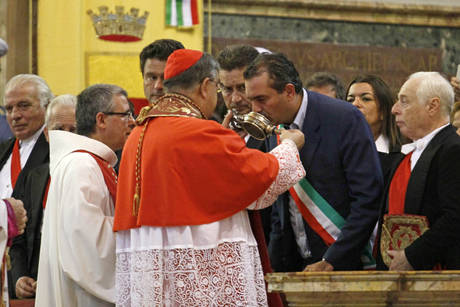
Cardinal, mayor reject bid to cancel religious feasts
(ANSA) - Naples, September 19 - The Miracle of San Gennaro was repeated on Monday when the blood of Naples' patron saint liquefied at 9.30am.The event was announced to the thousands packing the city's cathedral and square outside, who cheered and let off firecrackers.
A visibly moved Cardinal Crescenzio Sepe, the Archbishop of Naples, held up a phial containing the blood of the 3rd-century saint while a traditional white handkerchief was waved.
Cardinal Sepe took the opportunity to reject government plans to cancel a number of saints' days, saying: "Naples cannot be cancelled from history".
Mayor Luigi de Magistris, elected in May, was among the politicians who paid homage to the saint by kissing the phial for the first time.
"Some people thought they could get rid of the feast of San Gennaro, because the government is on the way out," he said.
"But all of Naples is here, beyond political credos and religious convictions.
"Naples is a city in which there is a Catholic community, but also a secular one, a Jewish one, and a Muslim one".
The ceremony was broadcast live by a host of national and international TV networks.
The miracle takes place on the anniversary of the martyrdom of San Gennaro (St. Januarius) in September 305 AD.
The dried blood of the saint is preserved in two glass phials and traditionally liquefies three times a year, the Church says, thanks to the devotion and prayers of the faithful.
Aside from the anniversary of the saint's beheading, the miracle also takes place on December 16 to commemorate the 1631 eruption of Mt. Vesuvius, believed to have been halted by the saint's intervention, and again on the Saturday before the first Sunday in May.
On this occasion, there is a procession through the city's streets to recall the many times the relics have been moved over the centuries.
The liquefaction process sometimes takes hours, even days, and on occasions fails to happen at all.
SAINT'S LEGEND.
For the faithful and superstitious, the ritual's success is a good omen for the city while its failure is a sign of impending disaster.
In fact, disaster has struck on at least five occasions when the blood failed to liquefy, including in 1527 when tens of thousands of people died from the plague and in 1980 when 3,000 people were killed in an earthquake which devastated much of southern Italy.
The phials will remain on view in the cathedral for eight days before being returned to a vault in the chapel of the cathedral's treasury.
The first historical reference to the liquefaction of the martyr's blood is dated 1389.
Although now a headline-making saint, little is known about San Gennaro except that he was bishop of Benevento to the south of Naples and was martyred during the persecution of Christians spearheaded by the Roman Emperor Diocletian.
The bishop was beheaded for refusing to bow down to his 'pagan' persecutors.
According to legend, his body and head, still dripping blood, were gathered up by an old man and taken to a safe place while a local woman filled a phial with his spilt blood.
A group of Italian scientists has analysed the contents of the phials, establishing that they do contain blood, but have been unable to explain the phenomenon.
Some sceptics believe it is due to the shaking of the containers or the penetration of warmth from the holder's hands.
photo: De Magistris kissing phial

No comments:
Post a Comment